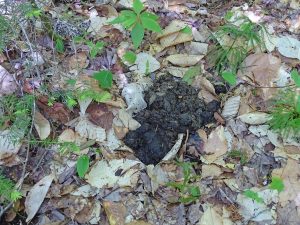After viewing Scott Leslie’s Video, I had one big question: What DOES it take for a site to be protected as Old Growth in Nova Scotia?
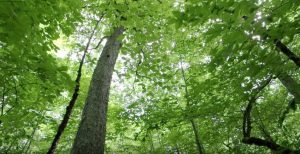 CONTENTS
CONTENTS
– THE VIDEO
– THE LITTLE BROWN BAT
– WHAT IT’S ABOUT
– VIDEO TEXT
– The LOCATION & a BRIEF HISTORY
– ON THE LITTLE BROWN BAT (LINKS)
– A FEW COMMENTS
Related Post: Nova Scotia’s Old Growth Ground Zero: the Corbett Lake Old Hardwood Forest 17July2019
THE VIDEO
Corbett Lake Old Growth, Annapolis County, Biodiversity Jewel Threatened
By Scott Leslie, Published on YouTube on July 12, 2019
THE LITTLE BROWN BAT (Species-at-Risk):
“I have discovered that endangered little brown myotis are living at, or near the site. I used a ultrasonic bat detector and got some great recordings. Example. If they cut that Corbett Lake site, they’ll probably take down the bats’ roosting/maternal trees.” – Scott Leslie to NSFN, July 12, 2019.
An example of the recordings:
Says Scott: …”we are now very concerned that logging will commence this fall. Given the presence of Myotis lucifugus we are extremely worried that these animals, on the verge of extirpation in NS and whose numbers have declined by 95% in the past 15 years or so, will not survive the destruction of their habitat here. If they return in spring and their roosting and maternal trees are damaged or gone or the habitat surrounding them has been destroyed they may not survive. If this does happen, it will be a contravention of the law and spirit of both SARA and the NS Endangered Species Act. CWS and ECCC have been advised of the presence of these bats here and so has the province.
WHAT IT’S ABOUT
The Video begins with drone footage above the Corbett Lake Old Growth, then descends into the forest through its multilayered canopy. From there Scott takes us through a set of slides illustrating species and features of the forest, described in text (reproduced below). There is no sound.
The Video gives a very good Sense of Place, its ecological functioning, and of the host of species for which this forest is home. It is also a message of apprehension, of immense concern that all of that is about to be lost, the foresters’/L&F contention that they can both log it and retain its natural character notwithstanding.
The final text asks viewers to “Contact Premier Stephen McNeil (Corbett Lake old-growth is in HIS riding) and Minister of Lands and forestry Ian Rankin and tell them not to cut the Corbett Lake Old Growth.”
Please do.
Scott’s observation (acoustically) of the Little Brown Bat in the area adds one more SAR (Species-at Risk) to the two previously found to be present as a result of the Annapolis Ecology folks highlighting the plans to cut the area, and then beginning to do their ground-truthing of this piece of Crown land; in the process they attracted others, including Scott Leslie, to assist them in their investigations.
Scott Leslie is an award-winning Nova Scotia author, naturalist and nature/wildlife photographer. his works including seven books on natural history and the environment, among them Woodland Birds of North America- A Guide to Understanding, Observation and Conservation; 100 Under 100- The Race to Save the World’ Rarest Living Things; and his latest – Untamed Atlantic Canada- The Region’s Biodiversity Havens. He was a co-founder of the Tobeatic Wilderness Committee which instrumental in having that area protected in the 1990’s.
Scott has been alarmed by the intensity and extent of clearcutting in NS (view Posts Dec 9, 2017 and Jan 10, 2018). It was Scott’s filming of Chimney Swifts at the Corbett Lake Old Growth Forest and reporting that to L&F that triggered Minister Rankin’s instructions to put a hold on logging pending the results of their own investigations of the area.
Thank you Scott Leslie for so eloquently expressing and sharing your concerns.
—–
VIDEO TEXT
Scott is also making a PDF with the slides and text available.
1. Complex, old ecosystems like Corbett Lake provide a rich, healthy habitat for nearly 20 species of migratory songbirds. The Little Brown Bat also lives here. It is critical habitat for this species that is listed “at risk of extinction under the Canadian Species at Risk Act.
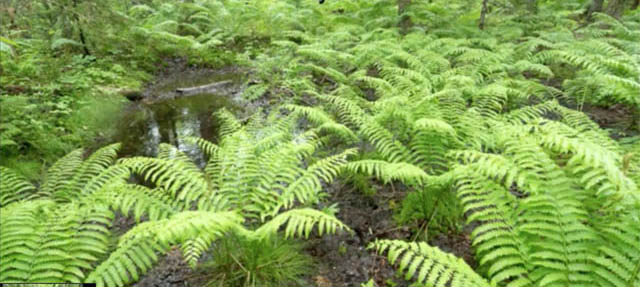
2. A seasonal stream runs through the centre of the 19 hectare site. This kind of habitat enhances the biodiversity of the forest.
3. An abundance of lichens growing throughout the site is a sign of a healthy, vibrant ecosystem.
4. The open canopy of the old growth forest allows light to penetrate to the ground resulting in a complex layered vegetation structure.
5. Because the old growth forest is bordered by Corbett Lake, amphibian species such as threatened salamanders, American toads and the familiar spring peepers are found here in abundance.
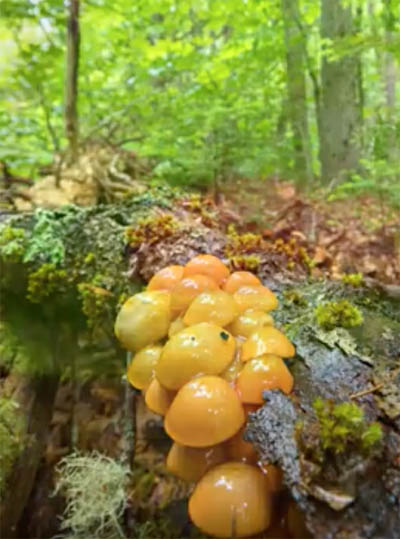 6. Rotting logs and other decaying material on the forest floor provide food for a diversity of fungi and moss species, such as this cluster of yellow mushrooms.
6. Rotting logs and other decaying material on the forest floor provide food for a diversity of fungi and moss species, such as this cluster of yellow mushrooms.
7. Only in an undisturbed forest will such a multitude of wildflowers and other woodland plants survive. They are the sign of a healthy, water-balanced habitat
8. All levels of a typical complex old growth forest are apparent here, from the ferns, to balsam fir saplings, to young birch up to grand yellow birch and sugar maples. Birdlife thrives in this multistoried ecosystem.
9. Ladyslippers, bluebead lily, cucumber root, lily of the valley and wild sarsaparilla are found throughout the old growth site.
10. This male blue-headed vireo, a species protected under the Migratory Birds Convention Act, is singing its spring breeding song. Such behaviour is indicative of breeding, and when a female is seen nearby, a nest is also near. They are common at the Corbett Lake old growth site.
11. The luxuriant growth of ferns and other vegetation die and decay every year to create a rich soil layer so crucial for year over year plant fertility, carbon sequestration, invertebrate and micro-organism diversity.
12. The ecological complexity that defines an old growth forest is now rare in Nova Scotia. 99.5% of all such forests have disappeared in the province, heightening the value of places like the Corbett lake forest
13. Viburnum (hobblebush) that grows in the understory at Corbett Lake. Such delicate shrubs need such conditions to thrive.

14. Protected under the Migratory Bird Convention Act, a male winter wren sings to establish a territory in spring. Several pairs of this species nests in the 19 ha old-growth site at Corbett Lake.
15. The Corbett lake old-grwoth forest hosts the tiniest ferns to massive 200 plus year old yellow birch trees. Only in such a pristine place is it possible for such a range of life to thrive.
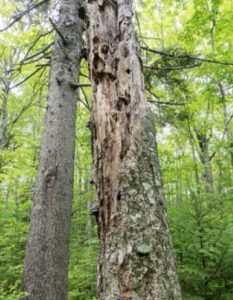 16. A centuries old dead hollow tree similar to this one provides a nesting home for the Chimney Swift, a bird listed as in danger of extinction. Under the Canada Species at Risk Act, it is ILLEGAL for logging operations to destroy such habitat.
16. A centuries old dead hollow tree similar to this one provides a nesting home for the Chimney Swift, a bird listed as in danger of extinction. Under the Canada Species at Risk Act, it is ILLEGAL for logging operations to destroy such habitat.
soul
17. More than just a biodiversity sanctuary, the Corbett Lake old growth forest not only provides a rich, abundant life for a myriad of living things, with its amazing sights and sounds, it also uplifts the human soul
18. The cycle of like continues as newly fallen leaf lies on a newly emerging fern. Nature ever renews itself when given the chance. Sadly, renewal from a clearcut is a different story.

19. A male black-throated blue warbler, protected under the Migratory Birds Convention Act, perches above his female mate sitting on her eggs on the next. Is it too much for humans to consider the lives of wild things before we destroy their homes with little thought for their future or even of the sustainability of a healthy environment for ourselves?

20. This female black-throated blue warbler sits on her nest. Will this be the last time she will raise a brood of four chicks at the Corbett Lake old growth forest? A 2013 scientific study estimated that up to 160,000 migratory bird nests are destroyed by logging in NS every year. With four chick average per nest, the number is even more staggering.
19. A male northern parula sings to its mate on their nearby nest. Like the other 20 or so species of migratory songbirds nesting at Corbett Lake, parulas return each spring to the same forest to breed. Tragically, if this site is logged in the fall of 2019, as is planned. These birds will return to a devastated, unlivable place next spring. Their homes will have been destroyed.
 21. One the ancient yellow birch trees at Corbett Lake old growth forest. Many are even larger than this. We must save and protect such rare places to ensure the survival of biodiversity ad a healthy environment for us all.
21. One the ancient yellow birch trees at Corbett Lake old growth forest. Many are even larger than this. We must save and protect such rare places to ensure the survival of biodiversity ad a healthy environment for us all.
22. A logging road has already been built along the border of the old growth site. It waits for the mechanical harvesters, due to begin cutting this fall. Please help us stop them.
23. This is what awaits the Corbett Lake old-growth site: being mowed down like a field of weeds, resulting in the destruction of hundreds of nests and other wildlife – illegal under the Migratory Bird Convention Act. Located in Annapolis County, like Corbett lake, this younger forest was utterly destroyed recently. Contact Premier Stephen McNeil (Corbett Lake old-growth is in HIS riding) and Minister of Lands and forestry Ian Rankin and tell them not to cut the Corbett Lake Old Growth.
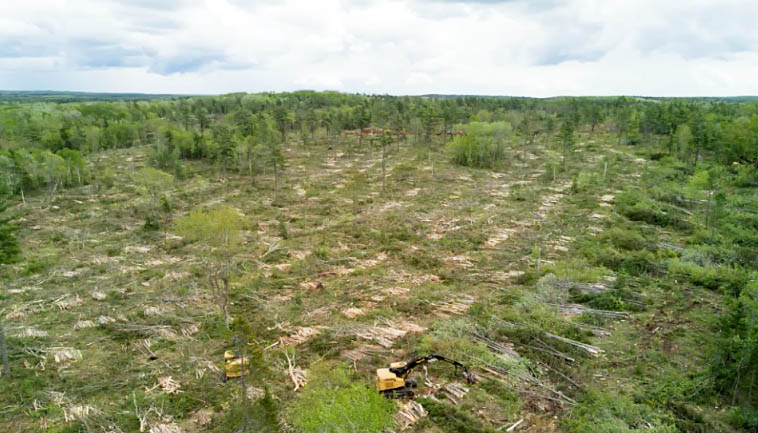
Thank you Scott Leslie for expressing so well the qualities of this forest.
ON THE LITTLE BROWN BAT (LINKS)
Little Brown Bat
On Hinnterland Who;s Who (by Canadian Wildlife Service and the Canadian Wildlife Federation) Detiled description of the bat, habitat, threats etc.
Little brown bat colony discovery a ‘glimmer of hope’ for N.S. population
Carly Stagg · CBC News August 5, 2016
Nova Scotia bat monitoring website reopens
Truro Daily Jun 28, 2018
Nova Scotia Bat Conservation
MTRI/NS Gov For reporting sightings
Little brown myotis, northern myotis and tri-coloured bat
COSEWIC assessment and status report 2013
THE LOCATION & a BRIEF HISTORY OF RECENT ISSUES RELATED TO THE CORBETT-DALHOUSIE LAKES PENINSULA
For a more detailed version, see Nova Scotia Old Growth Ground Zero
Location of the Corbett-Dalhousie Lakes Peninsula
(Click on image for larger version)
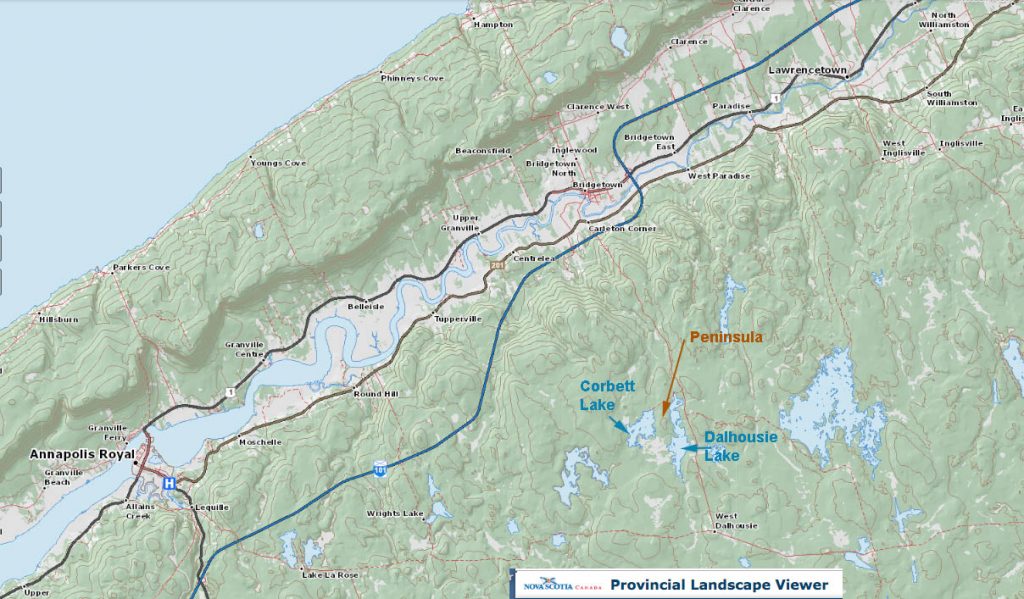
Location of the Corbett Old Growth Forest on The C-D Peninsula and a brief history
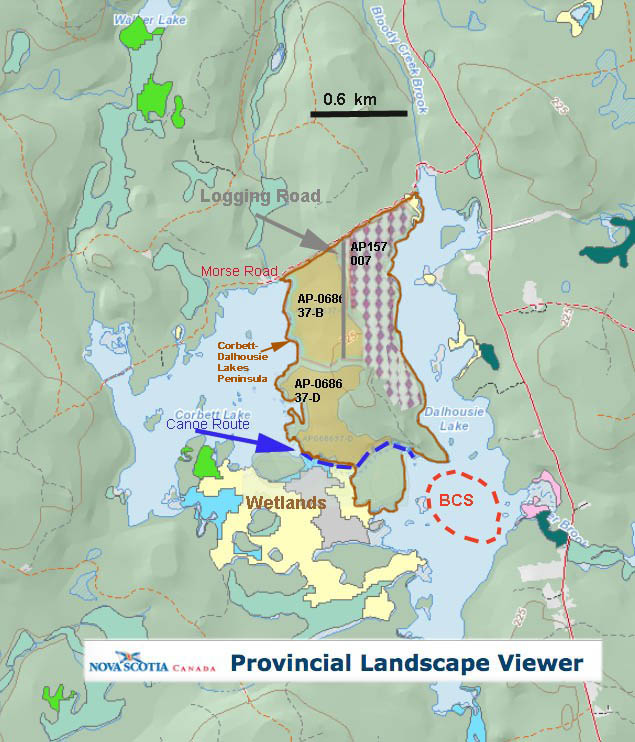
The Map Above shows the Corbett-Dalhousie Lakes Peninsula, Crown land parcels approved for logging on the peninsula (approximate representation; some harvesting has already taken place, location of the canoe route between the two lakes; and the BCS (Bloody Creek Structure). The northwest block (AP-068637-B) is the area of Old Growth described by Scott Leslie; it is mostly Multi-aged-Old Forest by DNR classification (see next map below).
AP-068637-B and AP068637D were originally proposed as clearcuts in 2014; they were approved as partial cuts in 2018, and logging began the same year. These two blocks were reposted by L&F on the HPMV for comment in December 2018, apparently by mistake; that alerted the local community of the cuts, an area they/the county valued for recreation, canoeing in particular. Followup investigation in the spring and early summer revealed Species at Risk and that trees over 130 years old had been cut – yet L&F said the area does not meet the requirements to qualify as Old Growth
In the spring of 2019, Annapolis County Council asked the province to allow the county to manage the whole peninsula as a “a climate forest and [to] demonstrate that a new economic model based on ecological forestry management can increase local jobs, community recreation, and tourism”. The request was turned down.
On June 14, 2019, logging on the peninsula was put on hold while the province investigates reports of several Species at Risk in the area (Chimney Swifts, Blandings Turtle and now Little Brown Bat).

The C-D peninsula was entirely mature and multi-aged/Old Forest before logging began. Note the prevalence of “Establishment” stage forest in the area, which is forest that was clearcut within the last 20-30 years.
A FEW COMMENTS
I visited the site on June 15, 2019 when some very determined women were still camping out on the logging road under the banner of Extinction Rebellion Nova Scotia. It was also, as it turned out, only one day after Minister Rankin announced the logging was put on holding pending investigation of the reports of Species-At-Risk.
Two features of the Corbett Old Growth site, in addition to many of those described by Scott, made an impression on me.
One was the many recent bear droppings (scat), certainly in greater density than I have ever seen. I wondered if that had anything to do with the recent past and ongoing logging on the Peninsula.
The second was the pronounced pit and mound topography over most of the site. This feature is not amongst the criteria in the L&F Old Forest Policy for classifying a stand as Old Growth but it really should be. Says JOE RANKIN citing Andrew Whitman at the Manomet Center for Conservation Sciences and Shawn Fraver, a professor at the University of Maine’s School of Forest Resources in Old Growth” Forests Defined by Key Ecological Characteristics:
…One other telltale feature of an old growth forest is the forest floor itself, said Whitman and Fraver. It’s not, by any means, level. Instead it’s characterized by dips and mounds. Not coincidentally they’re more or less the size of a large tree’s root ball and its accompanying soil. This “pit and mound” topography occurs when old big trees are blown down, their roots upended. The mound is created by the exposed root ball, the hollow is where it once was. Gradually, over decades, the root rots and both the mound and pit are colonized by mosses, ferns, wildflowers and young trees.
“It could take an old field a thousand years to get that pit and mound topography,” said Whitman. “In managed forests you rarely get that, because large trees are cut before they can fall down”
The lack of pit and mound topography is a good indication that the land was once smoothed by the plow, even if it was a century or two ago. For Fraver, there’s one pretty sure indication that a forest wouldn’t qualify it as old growth. “If I see cut stumps that is evidence that it’s been harvested.”
I also walked through a patch of forest on the east side of the logging road that had been logged in 2018 as a Uniform Shelterwood cut. It was, I was told by an expert who was with me, well executed. However the canopy had been opened up and there was a lot of drying out of the soil surface not seen in the intact forest. Most notably, there were none of the big old trees or snags seen in the intact forest that provide habitat for many of the old forest species. And without the large trees to form tipovers and mounds, an important natural process was interrupted. I was told that overstory removal could occur when the undergrowth reaches 1.3 m and it was almost there.. so within a few years of the first cut, even what remains of the overstory could be removed. As far as I could see, it was a ‘uniform cut’; no large patches of intact forest were retained. So while the cut may represent ‘good forestry’, it is still seriously degrading the old forest habitat.
Sadly, some large hollow tree trunks stood discarded by the road. I suppose that’s better than making chips for bioenergy out of them, but.. why couldn’t they have been left standing as they were? I am told that Danny George regularly drills into a prospective large yellow birch to determine if it is firm. If it isn’t, he leaves it there. And why can’t we do Tree Marking in Nova Scotia, at least on these old forest sites?
I am far from an expert. These are my impressions and questions. After viewing Scott Leslie’s Video, I had one big question:
What DOES it take for a site to be protected as Old Growth in Nova Scotia, or even as an Old, Biodiverse Forest less than 125 years of age (the cutoff for Old Growth under the Old Forest Policy)?

